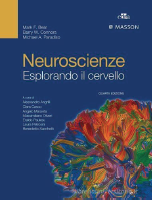BOOK REVIEWS, NOTES AND COMMENTS

NEUROSCIENZE
Esplorando il cervello
Mark F. Bear, Barry W. Connors, Michael A. Paradiso
Milano: Edra SpA; 2016. 1012 p.
ISBN 9781451109542
€ 79,00
[Neuroscience: Exploring the Brain]
This is definitely a very brilliant volume which is organized as a textbook but can have its own value in the bookshelf of anyone who today operates in similar sectors or in fields not too far from neuroscience. In the scientific and biomedical world, including the area of medical clinic or applied psychology, there is a growing interest, ranging from a spontaneous curiosity toward molecular mechanisms, cellular and tissue processes, central nervous system functioning (the brain, also called “the organ of thought”) and the offshoots of the peripheral nervous system. Along with the well-known increases in neurodegenerative pathologies, as from Alzheimer disease to the spectrum of Parkinsonism, there are also increases in peripheral neuropathies, as well as in pain control, especially in the case of long-term cancer survivals.
This wonderful book, composed of 25 chapters (each chapter has many different inserts in depth), is divided into 4 main sections, each of a different topic and color: “Foundations”, “Sensory and Motor System”, “Brain and Behaviour” and “The Changing Brain”. It is the very well accomplished Italian translation of the 2016 version of Neuroscience: Exploring the Brain (the 4th edition).
This book is not only a brilliant source of study. It can be used as an encyclopedic reference, almost a sort of dictionary, where you can easily find updated information on various sectors. It is also rich of colored and accurate images and at the end of the first section “Foundations”, you can find a guide of over 40 pages illustrating in detail human neuroanatomy. Moreover, at the end of every chapter you find a box with the key words, review questions and suggested reading. A detailed glossary and a relevant index enrich the end of this stimulating text.
As a whole, the book is written fluently, updated from a scientific point of view but in particular it also provides historical perspectives that, especially for what concerns the subsequent stages of methodological improvement, are really a useful complement to a basic narrative.
Stella Falsini and Enrico Alleva
Istituto Superiore di Sanità
Roma
